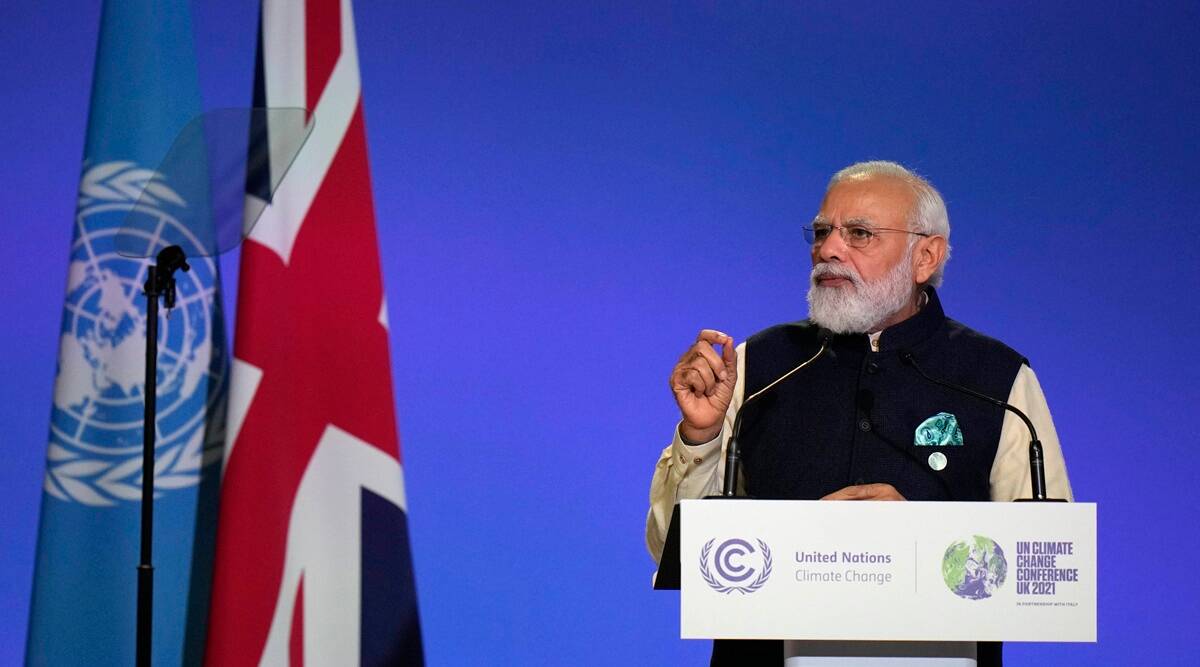 Prime Minister Narendra Modi
Prime Minister Narendra ModiIncorporating two of the promises made by Prime Minister Narendra Modi at the Glasgow conference last year, India on Wednesday enhanced its climate change targets for 2030. India has said it was now committing itself to at least 45 per cent reduction in emissions intensity of GDP (emissions per unit of GDP) from 2005 levels. The existing target was a 33 to 35 per cent reduction.
At the same time, India is also promising to ensure that at least 50 per cent of installed electricity generation capacity in 2030 would be based on non-fossil fuel-based sources. This is an increase from the existing 40 per cent target.
Both these enhanced targets have been included in India’s updated NDC, or nationally determined contributions, that every country has to periodically finalise and submit to the UN climate body. The updated NDC was approved by the union cabinet on Wednesday. India’s first NDC was submitted in October 2015, just ahead of the finalisation of the Paris Agreement, which formalised this process.
“The updated NDCs seek to enhance India’s contributions towards the achievement of the strengthening of global response to the threat of climate change, as agreed under the Paris Agreement. Such action will also help India usher in low emissions growth pathways,’’ said a statement from the Environment Ministry.
Subscriber Only Stories
India’s first NDC had eight goals, but only three had quantified targets. Apart from the two mentioned above — those relating to emissions intensity, and proportion of non-fossil sources in electricity generation – India had set a forestry target, promising to create an additional carbon sink of 2.5 to 3 billion tonnes of CO2 equivalent by 2030.
In Glasgow last year, Prime Minister Modi had made a series of new promises to strengthen climate action from India. Only two of them, mentioned above, have been converted to official targets, but the others are also inter-linked, and progress on one would lead to corresponding progress on others.
Government sources said India was already on the path of achieving its two existing non-forestry targets, and, therefore, an enhancement was expected. Officials said the achievement of the new NDC targets was “contingent upon the receipt of climate finance and technology” from developed countries.
“While these are achievable targets, they will be difficult to meet without resources,’’ said sources.
Pointing out that the new NDC demonstrated India’s commitment at the highest level for decoupling of economic growth from greenhouse gas emissions, the Environment Ministry said the enhanced target was also step toward achieving net zero status by 2070. Net zero is a situation in which a country’s emissions are balanced by absorption or removal of carbon dioxide from the atmosphere.
“As a result of the aforesaid measures, the Net Zero target by 2030 by Indian Railways alone will lead to a reduction of emissions by 60 million tonnes annually. Similarly, India’s massive LED bulb campaign is reducing emissions by 40 million tonnes annually,’’ the ministry statement said.
The updated framework for India’s transition to cleaner energy between 2021-2030 will include tax concessions and incentives such as production linked incentive scheme for promotion of manufacturing and adoption of renewable energy. It will provide an opportunity for enhancing India’s manufacturing capabilities and exports, and will lead to an increase in green jobs in renewable energy, clean energy industries.
Climate expert and IPCC author Prof Navroz Dubash from the Centre for Policy Research, said the updated NDCs have “simplified’’ and “clarified’’ the earlier targets which were ambiguous.
“According to our analysis, India’s emissions intensity has been dropping steadily compared to other countries even though India is at a lower level of GDP. A 45% carbon intensity reduction is likely to be achievable based on current policies,’’ he added.
Dubash, however, pointed out that the Centre might have missed an opportunity by limiting its pledge on renewable energy to installed capacity instead of setting targets for generation.
- The Indian Express website has been rated GREEN for its credibility and trustworthiness by Newsguard, a global service that rates news sources for their journalistic standards.

